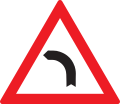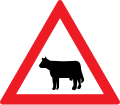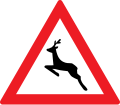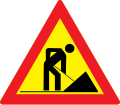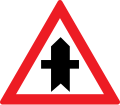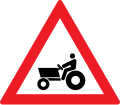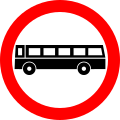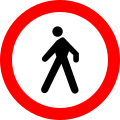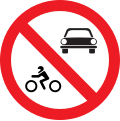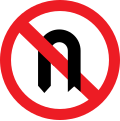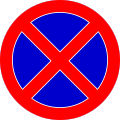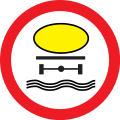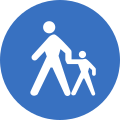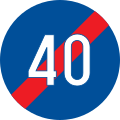History
After the inclusion of Dacia in the Roman Empire, the Romans built a road network
In 1898-99, under the supervision of chief-Engineer Nestor Urechia, poles with informatory panels, showing several directions and distances, were erected at the beginning and the end of cities and villages along the national road from Câmpina to Predeal. Kilometric and hectometric milestones, based on a French contemporary model, were mounted by the road as well. They were replaced in 1910-11.[4]
In 1906, two years after its establishment, Automobil Clubul Român proposed the signalization of the main roads for the use of car owners, the number of whom kept growing (155 in 1906, 233 in 1907). The following year, its members decided upon enforcing 15 traffic signs, which were supposed to have inscribed, with white paint on a black background, the name of the club and the nature of the danger or warning ahead: bad pavement, passing underneath, level crossing, dangerous crossing etc. These signs were to be mounted on metal poles, about 150 meters before the dangerous area. The installation of these signs was carried out by ACR's members throughout the country.[5] On 15 April 1911, Romania ratified the 1909 International Convention on Motor Traffic, which came into force on 1 May 1912[6]. Thus were adopted the first four universal traffic signs: intersection (răspântie), level crossing (cale ferată), curve (cotitură) and ditch (groapă). These were circular, with white inscriptions on blue backgrounds and the name Automobil-Club Român written above the symbols[7].
Little has changed in the Romanian road signal system until the end of the 1920s. Where needed, local authorities would instate signs like ones for speed limit or bus/taxi station. On 15 May 1929, Romania ratified the 1926 International Convention relating to Motor Traffic, which came into force on 24 October 1930. The old signs were replaced by 6 triangular ones: ditch (șanț), curve (viraj), intersection (încrucișare), level crossing with barrier or gate (pasaj de nivel păzit), level crossing without barrier or gate (pasaj de nivel nepăzit) and a generic warning sign, with a thick border and hollow center, used where atmospheric conditions did not allow the previous signs to be installed or visible[8]. Since these were mounted by the same organization, now named Automobil Club Regal Român, they had the initials A.C.R.R. inscribed under the symbols. Six years later, Romania acceded to the 1931 Geneva Convention concerning the Unification of Road Signals, ratifying it on 31 May 1935[9]. The color scheme chosen for the signs was white background with red borders for prohibitory signs and blue background with white symbols and inscriptions for mandatory and informatory signs. The warning triangles, which were now seven with the addition of caution, were to keep their previous appearance. By 1940, other signs were introduced, such as no overtaking, horn prohibited and children crossing[10]. A road atlas published circa 1938, as well as pictures from war time and thereafter, suggest that until 1950 Romania used a mixture of the 1931 Geneva set, some of the German traffic signs from 1937, as well as locally instated ones[11]. However, the scarcity of traffic signs on national roads lead to the establishment, in 1942, of a Special Committee, under the patronage of the Government, which had to deal with this problem. The committee comprised representatives of the Ministry of Army Endowment, Ministry of Public Works, Ministry of National Culture and of Automobil Club Regal Român, which was natural since, in their annual report for 1942, the club emphasized that, from 1910 on, they were the only ones willing to manufacture and mount traffic signs in Romania, using public funds[12]. Some directional traffic signs were mounted as well by the Office of National Tourism (ONT), through their local representatives.
Given the political situation after the Second World War, Romania did not sign the 1949 Geneva Protocol on Road Signs and Signals, but kept for more than 11 years its own particular set. Early traffic laws did not provide templates for traffic signs, that being the responsibility of the Miliția[13][14][15], based on the exisiting national standards[16]. The Romanian Standards Commission, established in 1948, elaborated the first standard regarding traffic signs in 1950: STAS 1848-50. All signs had a yellow background, even no entry, no parking, mandatory and informatory ones. The standard was first updated in 1957, among others introducing the signs roadworks and stop, the latter which had a particular design: a yellow circle with a red border and an inscribed blue equilateral triangle pointing upwards. STAS 1848 was later modified several more times, in order to reflect changes in national legislation or adhesion to international agreement and protocols.
On 5 December 1960, Romania eventually ratified the 1949 Geneva Protocol on Road Signs and Signals[17] and subsequently denounced the 1931 Convention[18]. The only reservation expressed was that Romania did not consider itself bounded by the article 62 of the Protocol, since it believed that for solving disputes in the International Justice Court, both parties had to agree to take that course of action. This adhesion, as well as the Amendments to the Protocol which entered into force on 22 October 1964, determined the national standard to be changed in 1961 and 1965. The former standard, adopted in November 1961, entered into force on the 1st of April 1962[19]. In these standards, apart from the international set of signs, others were adopted, such as turning point, no stopping, no carriages. The warning, prohibitory, directional and additional signs kept their yellow background. In 1963, a separate standard was adopted for signaling railroad crossings: STAS 1244-63[20]. It was in 1966 that new traffic rules included for the first time an annex with 118 signs divided into danger warning, regulatory and orientation-related and various.[21][22] The new set was standardized the same year, in the fifth edition of STAS 1848.
Romania was one of the signatories of the Vienna Convention on Road Signs and Signals from 8 November 1968, the only reservation being: "the Socialist Republic of Romania does not consider itself bound by the provisions of article 44 of this Convention" and choosing danger warning sign Aa (triangular) and stop sign B,2a (octagonal), as requested by article 46(2). It also signed the European Agreement supplementing the 1968 Convention on Road Signs and Signals from 1 May 1971. The ratification of both acts followed on 9 December 1980[23]. However, the development of the Romanian automotive industry as well as the continuous increase of the number of vehicles on road entailed immediate changes. In 1970 the traffic rules were republished with a new annex, containing 30 more signs: 4 warning, 4 prohibitory, 2 mandatory, 3 orientation-related, 12 informatory and 5 additional. Among the most important changes, the background of the warning and regulatory signs became white, that of directional signs turned blue, while an informatory pedestrian crossing sign replaced the triangular warning one in signaling crosswalks[24]. The changes stipulated in the 1970 decree annex as well as the provisions of the 1971 European Agreement were standardized by STAS 1848/1-71 and STAS 1878/2-71. Some signs were eliminated, such as dangerous curves, control post, no parking, end of honking prohibition, road refuge (introduced only one year before), no entry for automobiles, horse-drawn carts and bicicles. Others were modified: among others, the octagonal stop sign replaced the old circular one and the warning and informatory pedestrian crossing signs got zebras instead of parallel dotted lines. A number of 14 signs were newly introduced: 3 warning, 3 prohibitory, 1 informatory, 1 directional and 6 additional[25]. In order for these changes to become legally binding, the annex of the 1966 Decree was again modified and republished in 1972[26]. WHAT
In 1984...[27]. 2002[28][29] and 2006[30].
| Evolution of the Romanian STOP sign
|

|

|

|

|

|

|

|

|
| 1957
|
1961
|
1966
|
1970
|
1971
|
1977
|
1986
|
2011
|
National Standards
- 1961 (ratification of the 1949 Geneva Protocol on Road Signs and Signals)
- 1965 (new traffic law adopted in 1962)
- 1966 (new traffic law adopted in 1966)
- 1971 (changes to the 1966 traffic law, as well as signing of the 1971 European Agreement regarding Traffic Signs)
- 1986 (more changes to the 1966 traffic law)
During these updates, STAS 1848 was first split into two separate standards: STAS 1848/1, establishing the general aspect of the traffic signs and STAS 1848/2, dealing with technical requirements and drawing sheets. The latter was itself split in 1986 into STAS 1848/2 and STAS 1848/3, the third one dealing exclusively with writing (including character drawing sheets) and text composition.
After the reorganization of the Romanian standard system in 1992,[31] the standards regarding traffic signs were revised in 2004 as SR 1848:1-2004, SR 1848:2-2004 and SR 1848:3-2004, all three being updated again in 2008 and 2011 in order to reflect changes in national legislation and the adoption of certain European standards, like SR EN 12899 – Fixed, vertical road traffic signs.
The aspect of milestones was regulated by a separate standard, established in 1964: STAS 6900 – Road works. Kilometer and hectometer stones. It was updated in 1978 and 1979, and then revised in 1995 as SR 6900. Its provisions were included in SR 1848/2008 series, and subsequently the standard was canceled.










